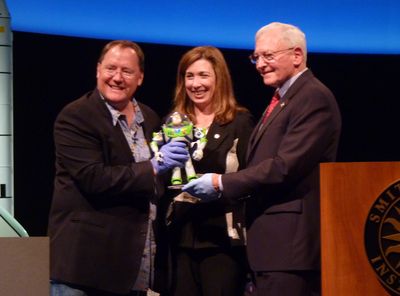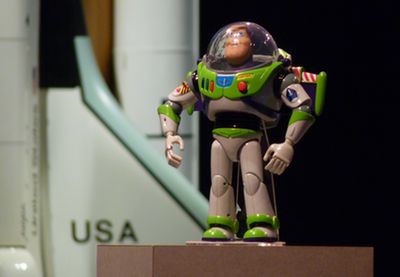To infinity and the Mallby Jeff Foust
|
| Had Buzz been an actual astronaut, the 468 days the toy spent in space would have set a spaceflight duration record. |
Last week at the National Air and Space Museum in Washington, a Buzz Lightyear action figure—an actual figure, not the animated one from the big screen—was the center of attention. This time, though, Woody’s exclamation rung hollow. This Buzz Lightyear was more than a toy: it was now, at the very least, a museum artifact, added to the museum’s collection for its unique journey into space. And, perhaps, it was something more.
The Buzz Lightyear figure formally accepted into the museum’s collection during a ceremony Thursday had flown in space. Launched into space aboard the space shuttle Discovery on mission STS-124 on May 31, 2008, it stayed on the International Space Station for over a year, returning to Earth again on Discovery at the end of the STS-128 mission on September 11, 2009. Had Buzz been an actual astronaut, the 468 days the toy spent in space would have set a spaceflight duration record.
The reasons to fly the Buzz Lightyear figure were more than just for novelty, though. The joint effort of NASA and Pixar, the studio that produced Toy Story and its two sequels, was intended to be part of an educational outreach effort, with ISS crewmembers using the figure in educational videos, along with other educational materials designed to better, or at least differently, connect with students.
“As NASA explores beyond Earth,” said NASA deputy administrator Lori Garver at the ceremony, “we know we have to do things differently and we need to innovate. We also need to innovate in how we communicate the exciting programs that we’re doing to the public, and that’s what this mission is all about.”
That particular mission might not have captured a lot of headlines in the space industry itself, but it did win over students. “He was part of one of the most successful educational campaigns ever carried by the government in cooperation with the entertainment industry,” Garver said.
 John Lasseter of Pixar, NASA deputy administrator Lori Garver, and National Air and Space Museum director Jack Dailey pose with Buzz Lightyear at the ceremony. The gloves are designed to protect what is now a museum artifact. (credit: J. Foust) |
Simply arguing that Buzz Lightyear was a popular toy effectively used in an educational outreach program, though, might be missing the point. There is a certain emotional connection that many people have with the character, which remains popular today even with children who weren’t around when the original movie was released. A standing room only crowd, dominated by families, filled the museum’s Moving Beyond Earth gallery where Thursday’s ceremony took place; some lined up well before the gallery’s doors opened. A few even brought their own Buzz Lightyear figures.
| “Today is, without question, one of the greatest days of my life,” said Pixar’s Lasseter. |
That enthusiasm isn’t limited to children. In one video clip shown at the ceremony, astronauts on the ISS played with the Buzz Lightyear figure while eating dinner, a bit of goofing around not directly linked to any educational outreach work. And throughout the ceremony Thursday, Buzz Lightyear—the character and the physical toy joining the museum’s collection—was referring to as “he”, not “it”.
The person perhaps most excited about adding the space-flown Buzz Lightyear to the Smithsonian’s collection is the character’s creator himself. “Today is, without question, one of the greatest days of my life,” said John Lasseter, chief creative officer of Pixar and the man who created the Buzz Lightyear character for Toy Story, which he also directed.
Lasseter, born in 1957, recalled growing up with the early Space Age, enthralled by the astronauts flying the Mercury, Gemini, and Apollo missions. “They were my heroes,” he said. “They were, to me, the greatest. I just couldn’t believe how cool these guys were.” That experience led him to create the Buzz Lightyear character as the ideal “supercool” new toy for the movie. “Buzz is completely designed and patterened after my love, and all of our loves, of those incredible Apollo astronauts.”
In that respect, then, Buzz Lightyear has come full circle. A character in a movie—a toy—inspired by a director’s childhood fascination with spaceflight becomes an actual toy that gets to fly into space for the purpose of inspiring and educating a new generation. “Hopefully there’s a future astronaut out there that can land on a passing comet or something, an asteroid, that got into the space program because of this mission,” Lasseter said.
The Buzz Lightyear figure will go on public display at the museum later this summer, located in a mockup of a shuttle crew cabin at the main museum on the National Mall. The orbiter that ferried that figure to and from the space station, meanwhile, will also be joining the museum later this month at its Udvar-Hazy Center by Dulles Airport. Neither will fly in space again, but both, in their different, distinct ways, will have the opportunity to enlighten and inspire future generations.
